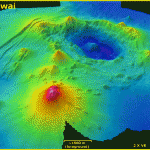
Stalagmites form when water containing calcium carbonate drips down onto the floor of a cave and leaves limestone behind when it evaporates. Image: Shutterstock/ Dumitrescu Ciprian-Florin
Cave formations can act as prehistoric weather stations.
Stalagmites collect different chemical signals from rainfall, soils, plants and the microbes living on their surface, recording any changes in these signals as they form. This provides a snapshot of what was happening in the local environment, as well as an overview of changes in temperature and rainfall.
“Looking at the molecules entrapped in stalagmites is a new way of looking at how vegetation has changed over time,” Curtin University researcher Dr Alison Blyth says. “The other great advantage is that, unlike with say pollen, we are not looking just at the vegetation, but also at molecules that will tell us about microbial activity, and the soil conditions — so the range of things we can look at in past environments is much bigger.”
The reason why stalagmites make such good archives of past changes is because they are very easy to date chemically and grow in laminations, much like tree rings. This makes it easier for scientists to match the chemical records from the environment with an accurate date and determine which changes happened at different times.
Blyth examines the organic molecules that become trapped in the stalagmites as they form. Changes in plant molecules may indicate variations in the overlying vegetation, while the molecules left on the stalagmite by bacteria respond to changes in temperature, allowing scientists to reconstruct past temperatures.
“As we can already reconstruct rainfall, vegetation regime, and changes in soil conditions from the same stalagmite, this opens up the possibility of creating a holistic record, looking at how the climate changed in the past, and how the ecosystem responded to that.”
The Nullarbor Plain, for example, is one of the largest areas of karst landscape in the world and the stalagmites that Blyth has examined from that area are between two and eight million years old. The Nullarbor is now too dry for these to form, suggesting that the environment has changed significantly in the past, and Blyth and her colleagues will be using the stalagmites as ancient weather stations to determine when these changes occurred.






